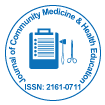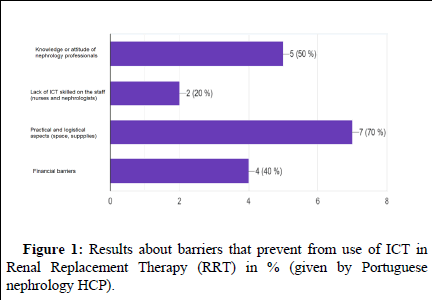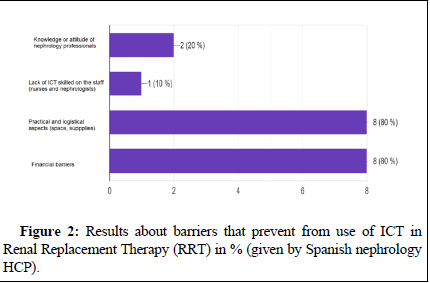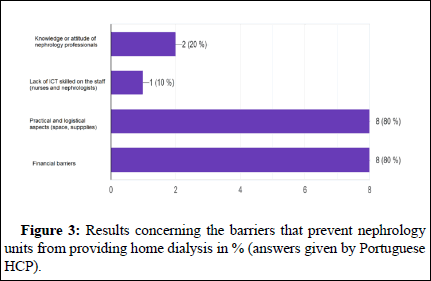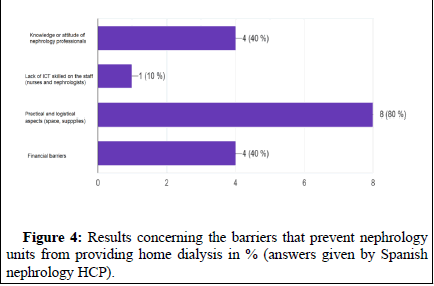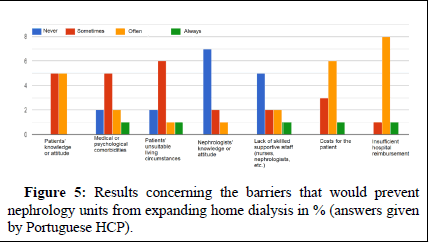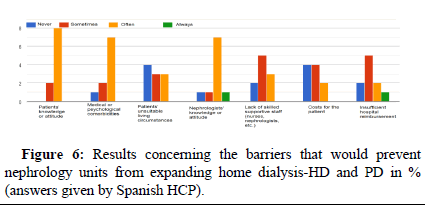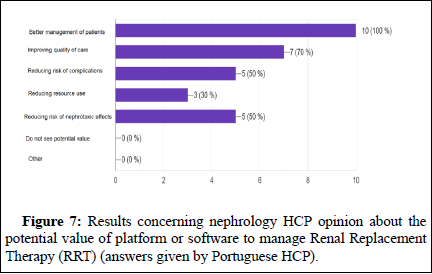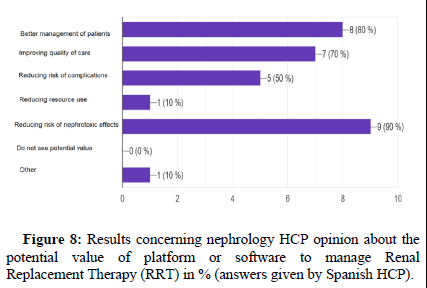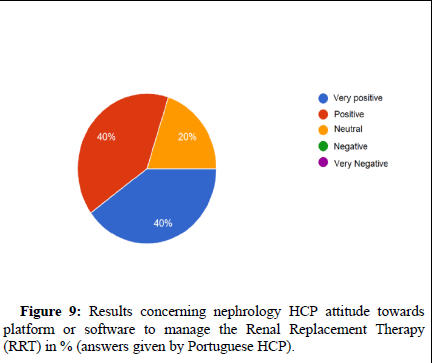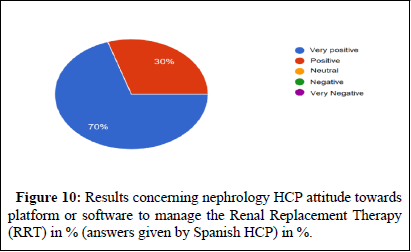Contribution to the Improvement of Healthcare in Nephrology through ICT Intervention: Survey Study to Portuguese and Spanish Healthcare Professional
Received: 09-Nov-2023 / Manuscript No. JCMHE-23-119687 / Editor assigned: 13-Nov-2023 / PreQC No. JCMHE-23-119687 (PQ) / Reviewed: 27-Nov-2023 / QC No. JCMHE-23-119687 / Revised: 13-Jan-2025 / Manuscript No. JCMHE-23-119687 (R) / Published Date: 21-Jan-2025
Abstract
Background and purpose: Chronic Kidney Disease (CKD) is a common chronic disease usually associated with Cardiovascular Disease (CVD), and premature death and millions of people are at increased risk for CKD. As this disease is extremely complex, Multidisciplinary Care (MDC) is needed to provide complete and continuous care. Usually, the nephrology units need cooperation from several other Healthcare Professionals (HCPs) such as cardiologists, nutritionists, obstetricians, and so forth. All modalities of treatments, Peritoneal Dialysis (PD) and Hemodialysis (HD) require HCPs and patients to develop a variety of skills to effectively deliver and manage dialysis tasks in the center or at home. Information and Communication Technology (ICT) interventions can offer tools that provide HCPs and patients with tools that facilitate the management of kidney patients in centers or at home. ICT interventions can allow to automate registrations, videoconferencing, minimize the geographic burden and resource cost savings. ICT can be the best way to promote cost saving on health spending and ensure the sustainability of the health system and, the environment as well. In the Iberian Peninsula, kidney patients consume about 3% of the total cost of healthcare. The cost of kidney transplants and dialysis is around 1.8 billion euros annually, and 75 % of this amount goes to dialysis treatment.
Objective: This study aimed to evaluate and analyze the opinion of Healthcare Professionals (HCP) in Nephrology units about the Intervention of ICT in nephrology care and the Clinical benefits results from the use of ICT in Nephrology Services and dialysis Units in Portugal and Spain. Thus we collected the opinion of health care professionals concerning the role of ICT intervention in nephrology. Understanding HCPs' feelings and attitudes is essential to understand if such technologies are correctly adjusted to the workflow and really bring huge benefits for the clinical practice of nephrology and also what features need improvement and what should be implemented in the future. ICT intervention has been implemented to promote better healthcare in nephrology units and improve patient outcomes. In the survey, we intended to evaluate nephrology HCPs' opinions concerning the ICT interventions, in nephrology, represented by several tools that allow the HCPs to implement solutions such as Remote Patient Monitoring (RPM), Remote Monitoring of Treatment (RMT), tele homecare, telehealth (tlenephrology), home dialysis, mHealth, mobile app, web portal, telemedicine, and so forth.
Keywords: Information and communication technology; RRT in Iberian Peninsula, Kidney disease; CKD; Renal replacement therapy
Abbreviations
ICT: Information and Communication Technology; CKD: Chronic Kidney Disease; DKD: Diabetic Kidney Disease; GFR: Glomerular Filtration Rate; ESRD: End-Stage Renal Disease; KDIGO: Kidney Disease: Improving Global Outcomes; PRISMA: Preferred Reporting Items for Systematic Reviews and Meta-Analyses; RCT: Randomized Controlled Trial; RRT: Renal Replacement Therapy; RPM: Remote Patient Monitoring; PD: Peritoneal Dialysis; HD: Hemodialysis or Hemodialysis; APD: Automatic Peritoneal Dialysis; CAPD: Continuous Ambulatory Peritoneal Dialysis; HHD: Home Hemodialysis; RRT: Renal Replacement Therapy; TX: Transplantation; RMT: Renal Management Therapy; RTS: Renal Therapy Services; EKHA: European Kidney Health Alliance; ICHD: In-Center Hemodialysis; HCP: Healthcare Professional, EU: European Union; ICHD: In-Center Hemodialysis; THC: Tele Homecare; PGHD: Patient-Generated Health Data; AAKP: American Association of Kidney Patients; PAHO: Pan American Health Organization; WHO: World Health Organization
Introduction
Key points
In many countries particularly in the Iberian Peninsula (Portugal and Spain) the incidence of CKD is substantially high. The “treatments” for kidney disease have not improved substantially over the past 50 years, leaving too many kidney patients with a poor quality of life and reduced life expectancy. This situation is associated with staggering aggregate annual costs amounting to €140 billion per year in Europe, more than the annual healthcare costs of cancer or diabetes [1]. The increased daily use of information and communication technologies may lead to the need for healthcare professionals to incorporate technology use competencies into practice.
CKD is defined as persistent “abnormalities of kidney structure or function, present for 3 months, with health implications”, and classified based on cause, glomerular filtration rate (GFR<60 mL/min/ 1.72 m2 (G1-G5)) category, albuminuria category (CGA>=30 mg per 24 hours (A1-A3)), age and in some cases the ethnicity. This results in the inability of the kidneys to filter the blood, resulting in an excessive build-up of fluid and waste products (e.g. drugs or their metabolites). CKD affects 8% to 26% of the population worldwide [2].
Nowadays improvements in assisting chronic disease patients, there is a wide possibility of using ICT in nephrology for training, assisting, or monitoring CKD patients. Due to those features, nephrology practice is experiencing improvements in safety quality of care, and quality of life for patients and HCPs as well.
CKD behaves like a multi-organ disease with complications that affect different organ systems and ICT can work as an excellent support in the activities of healthcare professionals of nephrology interchanging information with other healthcare professionals.
Information and communication technologies have the potential to improve health care for patients with chronic diseases [3].
CKD affected more than 55 million people in the European Union (EU). In 2016, 64 387 people died from kidney diseases and this caused almost 130,000 deaths in 2019. A vast majority of deaths from kidney disease concern people 65 years old or above. In the EU the death rate from kidney diseases is highest in Croatia (23 deaths per 100,000 inhabitants) and lowest in Finland (4 deaths per 100,000 inhabitants). The average standardized rate for the EU as a whole is approximately 14 deaths from kidney disease per 10,000 inhabitants. In 2016 Spain recorded about 14 deaths from kidney diseases per 100,000 inhabitants and Portugal registered about 16 deaths per 100,000 inhabitants [4].
In Portugal and Spain, the prevalence and incidence of patients under Renal Replacement Therapy (RRT) are high due to the high prevalence of patients with diabetes, High Blood Pressure (HBP), and obesity.
The use of information and communication technology in nephrology will be efficient only when the tools are correctly adjusted and integrated into the workflow processes and the users are trained.
CKD affects 9.1% of the global population and is spread heterogeneously throughout the world (10%-13% in Europe). All indications are that the incidence is higher in the elderly population and considering the aging trend of the European population, it is easy to understand that the number of patients will tend to grow, boosted by the increase in survival/longevity. The prevalence in stages 1 and 2 are about 50% and over time there have been no variations in age-adjusted prevalence this means that the increase is due to the aging of the world population and everything indicates that the numbers will continue to increase with the aging of the population.
According to the available data, in 2019, in Portugal 2673 patients started Renal Replacement Therapy. Portugal registered 378 kidney transplant transplants in 2020 and more than 1950 were on the waiting list [5]. According to the Spanish society of nephrology, the number of patients in renal replacement therapy is 3363, corresponding to 1922 patients on hemodialysis in health centers, 1334 to renal transplant recipients, 91 to peritoneal dialysis, and 16 to home hemodialysis [6].
The April 2021 publication shows that the survival trend is lower than in many cancer cases [7,8].
Overall in Europe, we are 10% of the population with CKD, amounting to >800 million individuals. In Portugal, the adult population is about 9 million, and 10% of this population (90 thousand) have DRC [9].
In Spain, there are also 10% of the population with CKD, representing about 1300 Nephrologists for 3.7 million patients with CKD [10].
The incidence of CKD in Europe is 128 cases per million inhabitants, in Spain it is a lithe higher, 170 cases per million inhabitants, and in Portugal is higher than in Spain, 229 cases per million inhabitants [11].
Thus CKD places a considerable burden on healthcare systems and government budgets. Indeed, annually there were millions of deaths in the EU resulting from CKD disease that used to be related to high blood pressure.
The persistent effect of high blood pressure in arteries may lead to the chronic failure of vital organs such as the heart, kidneys, or brain. In 2019, 22% of people in the EU aged 15 years and over reported having high blood pressure. Concerning the Iberian Peninsula, high blood pressure in Portugal affects around 27.5%, and in Spain 20% of inhabitants with 15 years old or above.
Digital health that is the information and communication technology intervention in medicine is spreading new tools to manage and support the clinical practice in distinct areas of medicine including nephrology, enhancing the possibility of including Tele-nephrology, home dialysis, RPM, RTM, and commercially available medical devices or technologies, such as mobile phone-enabled self-monitoring of biometrics data. Many of these new digital or ICT tools impact positively the patient-physician relationship. To ensure and speed up the widespread of ICT intervention in nephrology, it's crucial to know the feelings and perceptions of healthcare professionals about these technologies, and that is why we consider this study to be very useful for nephrology in the Iberian Peninsula.
Accordingly, we surveyed the nephrology HCPs, through the Portuguese and Spanish nephrology associations, societies, and units of nephrology to better know their needs and the professional perceptions of patients and their comfort level towards ICT interventions.
Materials And Methods
Research design and data collection procedures
The questionnaire was pre-tested, in Azores island hospital where the RRT platform was put in place recently, to verify the appropriateness of the questionnaire content. Content validity was ensured through an extensive literature review of academic and practical journals, as well as discussions with experts in this domain. Since ICT intervention is in its initial stage in several units of nephrology, numerous societies and units of nephrology and units of dialysis were contacted to try to reach as many nephrology HCPs as possible, which could enhance the effectiveness and scope of the survey.
We have contacted the information and communication departments of the hospitals of the main islands of the Azores (Ponta Delgada, Faial, and Ilha Terceira and asked them to spread the questionnaire by the HCPs. The feedback was enough to guide the second and definitive survey.
We created a definitive survey focusing on the 15 main subfields highlighted by the respondents of the pre-tested questionnaire. The definitive survey was distributed to the Spanish Society of Nephrology (SEN), Portuguese Society of Nephrology (SPN), renal nurses associations, nephrologists associations, and nephrology and dialysis centers located in the Iberian Peninsula (Portugal and Spain). We ask those institutions to distribute the survey to their nephrology HCPs [12].
To avoid the need for informed consent for ethical approval and accomplishment with personal data protection, we insert informed consent as the first, mandatory, and required answer to proceed with the other questions of the survey. In addition, the only personal data that were requested are the genre, the range of age, and profession.
A web-based (Google Forms) survey was completed by nephrologists and renal nurses working in the Spanish and Portuguese institutions of nephrology.
A detailed description of the survey objective was provided in the survey introduction. A total of 20 valid samples were retrieved, with females accounting for 55% of the respondents. Most of the respondents are in the 40-49 age group (60%), followed by the 26-39 age group (30%); 75% of the respondents have more than 3 years using computer to manage renal patients; the time working in nephrology units is 16-20 years’ group (30%), followed by 10-15 years’ group (25%) (Table 1).
| Characteristic | n=20 | |||
| Portugal | Spain | Global | ||
| Age group | 26-39=>1 | 26-39=>5 | 26-39=> 6 | |
| 40-49=>7 | 40-49=>5 | 40-49=> 12 | ||
| 50-59=>1 | 50-59=>0 | 50-59=> 1 | ||
| 60-69=>1 | 60-69=>0 | 60-69=> 1 | ||
| Woman | 4 (40%) | 7 (60%) | 11 (55%) | |
| Profession | Nephrologist | 3 (30%) | 1 (10%) | 4 (20%) |
| Nephrology/renal nurse | 7 (70%) | 9 (90%) | 16 (80%) | |
| Geographic area | Rural | 1 (10%) | 0 | 1 (5%) |
| Urban | 9 (90%) | 10 (100%) | 19 (95%) | |
Table 1: Demographic characteristics of respondents.
The questionnaire
At the beginning, we explained the objective of the questionnaire and asked for consent. Only the user that answers “Yes” forms for the first question can proceed with other questions of the survey. The first sentence was: “Please complete this ANONYMOUS survey, as your opinion is very important to us. Thank you, in advance, for taking the time to complete our survey”.
This study accomplishes all principles of good ethical research and does not use participants/respondents' data. Therefore this study does not require official approval from the ethics committee. Furthermore, the study is completely anonymous.
Firstly, respondents were asked for the genre, range of age, and profession, how long he/she has been working in nephrology, and how long she or he been using ICT tools in nephrology.
Secondly, respondents were asked about the RRT modality that he/he use to manage, the geographic area where he/she works, rural or urban, whether they use daily any kind of ICT tools to manage renal patients and some details and a deep opinion about the strengths and weakness that he found in ICT tools that he knows or uses daily [13]. The respondents were asked about the advantages and disadvantages that they found in ICT intervention.
The ten topics of the questionnaire used in this study are shown in Table 2. The measurement was clearly defined in each question.
| Questionnaire topic | Portugal (%) | Spain (%) | ||||
| ICT intervention in RRT | Affirmative | Null | Negative | Affirmative | Null | Negative |
| Improve patient safety | 70 | - | 30 | - | - | |
| Personalized treatment | 60 | - | - | - | - | |
| Total focus on the patient | - | - | 20 | - | - | |
| More than 5 years working without ICT intervention | 40 | - | 30 | - | - | |
| 1-5 years working without ICT intervention | 10 | - | - | 50 | - | - |
| Use ICT tools for RRT daily | 80 | 10 | 70 | |||
| The ICT tools is excellent for RRT | 40 | - | - | 80 | - | - |
| ICT tools are good for RRT | 40 | - | - | 20 | - | - |
| ICT improves the quality of RRT service | 50 | - | - | 60 | - | - |
| HCP feels comfortable using ICT for RRT | 80 | - | - | 80 | - | - |
| ICT for RRT has a positive effect on the patients | 50 | - | 10* | 80 | - | 20* |
| Not sure if ICT for RRT has a positive effect on the patients | - | 40 | - | - | - | - |
| The technical issue occurs sometimes | 70 | - | - | 70 | - | |
| Sometimes organizational issue occurs | 50 | - | - | 70 | - | |
| Would you recommend the ICT for RRT? | 80 | - | - | 90 | - | - |
| Using ICT for RRT is a very good solution | 50 | - | - | 70 | - | - |
| Total of CKD patients in your center is =or >100? | 50 | - | - | 30 | - | - |
| Total of CKD patients in your center is =or >200? | - | - | - | 30 | - | - |
| Practical and logistic aspect is the main burden for the spread of ICT in RRT | 80 | - | - | 80 | - | - |
| Financial barriers are the main burden for the spread of ICT in nephrology | 40 | - | - | 80 | - | - |
| Knowledge or attitude of nephrology HCP is the main burden for the spread of ICT in nephrology | 50 | - | - | 40 | - | - |
| Practical and logistic aspect is the main burden for the impulse of HHD | 80 | -- | - | 80 | - | - |
| Financial barriers are the main burden for the impulse of HHD | 80 | - | - | 40 | - | - |
| Knowledge or attitude of nephrology HCP is the main burden for the impulse of ICT in HHD | 20 | - | - | 40 | - | - |
| Your attitude towards ICT in RRT is very positive | 40 | 20 | - | 70 | - | - |
| Your attitude towards ICT in RRT is positive | 40 | - | - | 30 | - | - |
| Your attitude towards ICT in RRT is negative | 0 | - | - | 0 | - | - |
| Better patients management | 100 | - | - | 80 | - | - |
| Improving the quality of care | 70 | - | - | 70 | - | |
| Reducing the risk of complications | 50 | - | - | 50 | - | - |
| Optimize the use of resources | 50 | - | - | 90 | - | |
| Note: *respondents that said “Nothing changed, it is still the same” | ||||||
Table 2: Comparative summary of results with relevant (the highest) percentage.
Results
Between July 2021 and July 2023, the questionnaire was available online, and 20 answers were obtained (10 from Portugal and 10 from Spain). Of those replying to the survey, 80% were from public hospital centers and 20% were from private centers [14].
In Portugal, 100% of respondents had HD patients, 60% had PD patients, 30% had patients in conservative integral treatment, 0% had patients in HHD and 10% had kidney transplanted patients.
100% of respondents from Spain had HD patients, 40% had PD patients, 20% had patients in conservative integral treatment, 10% had patients in HHD and 10% had kidney transplanted patients.
A high percentage of the respondents had HD patients in both countries. From Portugal, we had a higher percentage of respondents with PD patients (60% vs. 40%). Any respondent from Portugal had patients in HHD but for kidney transplant we got the same number of respondents as Spain (10%).
Concerning using some ICT tools to manage kidney patients, 80% of Portuguese respondents said yes, and we got 90% yes from Spanish respondents [15]. 77.8% of respondents from Spain have been using ICT to manage kidney patients for more than 3 years, while in Portugal we found only 37.5% of respondents in this situation.
When questioned about the reasons for not using ICT tools to manage kidney patients, the answers were: From Portuguese respondents, lack of awareness of decision-makers (10%), lack of resources (10%), and tools unavailable (10%). Spanish respondents point to unawareness of the benefits (10%) and lack of resources (10%).
Referring to ICT available in the market, 40% of respondents from Spain declared that they were using Versia from Baxter, 10% were using Therapy Monitor from Fresenius, 10% were using Nexadia®, and the remaining 40% were using other solutions, instance: Nefrosoft and Irinis/Tgs (Diaverum). In Portugal 60% were using Therapy Monitor from Fresenius, 20% were using Versia from Baxter, and the remaining 20% declared that they were any ICT tool available.
Asking about RRT available in the workplace, 100% of the Portuguese respondents declared that HD (in the center) was available, 80% were PD available, 20% were self-care available, and 40% were comprehensive conservative management. 100% of Spanish respondents were HD available, 10% were HHD available, 40% were PD available, 30% were self-care available and 30% were comprehensive conservative management.
When asked about benefits received from ICT intervention, Spanish respondents refer to the Great efficiency of practices, taking into account the scarcity of human resources (20%), facilitating the creation, management, updating, and use of clinical information (10%); allow RPM (10%); allow to create reports and data analysis (10%); enhancing the patient autonomy and self-care (10%); improve workflow and time-saving. The Portuguese respondents highlighted the ability to create and manage clinical information (100%); Allow automatic registration and reduce human error (90%); enhance data access (80%); Show information about the patient status (70%); timesaving, paper-free, effective integrated care (60%).
When asked to summarize the role that ICT intervention can play in RRT, 70% of Spanish respondents mentioned patient safety; 60% mentioned personalized treatment; 50% mentioned productivity, paper-free, information-integrated, and reduced human error. The Portuguese respondents highlighted patient safety (30%); total focus on the patient (20%); and 10% refer to, information integration, treatment adherence observation, improvement of quality of care, agility and practicality for procedures, flexibility, and easy access to patient history [16].
From Portugal 40% of respondents were more than 5 years working without ICT intervention, 30% were more than a year, 20% were more than 20 years and 10% were between 1 and 5 years. 50% of Spanish respondents were between 1 and 5 years working without ICT interventions, 30% spent more than 5 years working without ICT intervention, 10 and spent more than 20 years working without ICT intervention and 10% spent less than 1 year working without ICT interventions the remains 10% were more than 20 years working without ICT intervention.
The respondents were using ICT intervention daily (80%) in Portugal and (70%) in Spain.
80% of Spanish respondents considered the ICT intervention as an excellent tool for RRT and the remaining 20% classified it as a good tool. 40% of Portuguese respondents considered it excellent, 40% considered it good, 10% considered it neutral and 10% did not know (Table 3 and Figures 1-10).
| Questionnaire topics | Portugal | Spain | ||
| Implications of ICT intervention in RRT | Nephrologist | Nurse | Nephrologist | Nurse |
| Improve patient safety | 66.7% | 71.4% | 0% | 33.3% |
| Personalized treatment | 100% | 71.4% | 0% | 0% |
| Total focus on the patient | 66.7% | 42.9% | 0% | 22.2% |
| ICT tools promote the integration and mobility of information | 100% | 57.1% | 0% | 11.1% |
| ICT tools promote cost-saving | 66.7% | 0% | 0% | 0% |
| ICT tools are excellent for RRT | 66.7% | 28.6% | 100% | 77.8% |
| ICT tools are good for RRT | 33.3% | 57.1% | 0% | 22.2% |
| ICT improves the quality of RRT service | 66.7% | 57.1% | 100% | 77.8% |
| ICT reducing human error | 66.7% | 42.9% | 0% | 0% |
| HCP feels comfortable using ICT for RRT | 66.7% | 100% | 100% | 88.9% |
| ICT for RRT has a positive effect on the patients | 66.7% | 42.9% | 100% | 77.8% |
| Not sure if ICT for RRT has a positive effect on the patients | 33.3% | 42.9% | 0% | 22,2% |
| Practical and logistic aspect is the main burden for the spread of ICT in RRT | 66.7% | 57.1% | 100% | 6/9% |
| Financial barriers are the main burden for the spread of ICT in nephrology | 66.7% | 28.6% | 100% | 77.8% |
| Knowledge or attitude of nephrology HCP is the main burden for the spread of ICT in nephrology | 66.7% | 42.9% | 100% | 33,3% |
| Practical and logistic aspect is the main burden for the impulse of dialysis at home | 100% | 6/7% | 100% | 77,8% |
| Financial barriers are the main burden for the impulse of dialysis at home | 66.7% | 6/7% | 100% | 33.3% |
| Knowledge or attitude of nephrology HCP is the main burden for the impulse of dialysis at home | 66.7% | 0% | 100% | 33.3% |
| Your attitude towards ICT in RRT is very positive | 66.7 | 28.6% | 100% | 66.7% |
| Your attitude towards ICT in RRT is positive | 0% | 57.1% | 0% | 33.3% |
| Your attitude towards ICT in RRT is negative | 0% | 0% | 0% | 0% |
| Better patients management | 100% | 100% | 100% | 88.9% |
| Improving the quality of care | 100% | 57.1% | 100% | 55.6% |
| Reducing the risk of complications | 66.7% | 42.9% | 100% | 44.4% |
| Optimize the use of resources | 66.7% | 57.1% | 100% | 88.9% |
| ICT promotes paper-free | 100% | 57.1% | 0% | 0% |
Table 3: Comparative results by profession and country.
Figure 1: Results about barriers that prevent from use of ICT in Renal Replacement Therapy (RRT) in % (given by Portuguese nephrology HCP).
Figure 2: Results about barriers that prevent from use of ICT in Renal Replacement Therapy (RRT) in % (given by Spanish nephrology HCP).
Figure 3: Results concerning the barriers that prevent nephrology units from providing home dialysis in % (answers given by Portuguese HCP).
Figure 4: Results concerning the barriers that prevent nephrology units from providing home dialysis in % (answers given by Spanish nephrology HCP).
Figure 5: Results concerning the barriers that would prevent nephrology units from expanding home dialysis in % (answers given by Portuguese HCP).
Figure 6: Results concerning the barriers that would prevent nephrology units from expanding home dialysis-HD and PD in % (answers given by Spanish HCP).
Figure 7: Results concerning nephrology HCP opinion about the potential value of platform or software to manage Renal Replacement Therapy (RRT) (answers given by Portuguese HCP).
Figure 8: Results concerning nephrology HCP opinion about the potential value of platform or software to manage Renal Replacement Therapy (RRT) in % (answers given by Spanish HCP).
Figure 9: Results concerning nephrology HCP attitude towards platform or software to manage the Renal Replacement Therapy (RRT) in % (answers given by Portuguese HCP).
Figure 10: Results concerning nephrology HCP attitude towards platform or software to manage the Renal Replacement Therapy (RRT) in % (answers given by Spanish HCP) in %.
Relevant comments from the respondents
Below, Table 4 we transcript questions and respective additional comments from survey respondents when we gave them space for comments about the previous question.
| Open questions | Portuguese HCPs comments | Spanish HCPs comments |
| How do you rate the quality of care delivered using the platform for renal replacement therapy when compared to the quality of traditional care? |
|
|
| Would you recommend the software or platform for management of renal replacement therapy? |
|
|
| Tell us what you most like about using this platform for renal replacement therapy management. |
|
|
| Where do you see the potential value of platform or software to manage the Renal Replacement Therapy (RRT)? |
|
|
| If you have any additional comments, we would be very pleased to hear/read them. |
|
|
Table 4: Set of additional comments given by the respondents.
When compared the traditional process with the ICT intervention in RRT, the opinion of Iberian Peninsula nephology HCPs (Portuguese and Spanish) is consensual: Almost the total respondents agree that ICT intervention brings the following benefits to nephrology care:
• Improves the quality of RRT service.
• Improves the quality of care.
• HCPs feel comfortable using ICT tools for RRT.
• Have positive effects on the patients.
• Financial barriers and practical and logistic aspect is the main burden for the spread of ICT in RRT.
• Financial barriers, knowledge, or attitude of nephrology HCPs is another burden for the spread of ICT in nephrology.
• Knowledge or attitude of nephrology HCP is the main burden for the impulse of dialysis at home. • HCP's attitude towards ICT in RRT is very positive.
• Promote better patient management.
• Reducing the risk of complications.
• Optimize the use of resources.
• It is excellent for RRT.
Therefore the above list of benefits, a high percentage of Portuguese nephrology HCPs also mentions the following benefits:
• Improve patient safety.
• Personalize treatment.
• Put total focus on the patient.
• Promote integration and mobility of information.
• Promote cost saving.
• Reduce Human error.
Discussion
This study was performed to collect the opinion of health care professionals concerning the role of ICT intervention in nephrology. Understanding HCPs' feelings and attitudes is essential to understand if such technologies are correctly adjusted to the workflow and really bring huge benefits for the clinical practice of nephrology and also what features need improvement and what should be implemented in the future.
Both surveys implemented collected the feeling of HCP professional about the roles of ICT intervention in nephrology care. The first one found the HCPs jumping form the traditional procedures to the lead with the ICT interventions [17]. The first survey gave good references to conduct the second and definitive that was made available for al dialysis units and societies of nephrology of Portugal and Spain.
Meanwhile, the survey model showed a good fit with our proposal and looks very good to guide future research to the primary care HCPs that lead to patients at risk of CKD. The results showed that ICT could also address the burdens of kidney disease spending, facilitating the implementation of multidisciplinary work, as demanded by multifactorial diseases such as CKD. The very demanded establishment of active cooperation between distinct departments of medical care can be enhanced by ICT interventions, and address the major problem caused. The survey results were analyzed using the core outcomes recommended by the standardized outcomes in nephrology. There were no answers reported adverse effects of ICT interventions, only positive or null effects. Despite the high interest in ICT interventions in nephrology, good quality evidence over a wider amount of HCPs and patients is needed to explore their real effectiveness and search for a better focus for exploring the potentialities of ICT intervention for CKD prevention through improving kidney disease screening [18].
The results indicated that the nephrology HCPs have a very good attitude towards the ICT interventions, they agree that the ICT tools bring better management of kidney patients and improve several aspects that impact the quality of service in nephrology.
CKD is extremely common and has emerged as one of the leading causes of death worldwide. CKD affects populations in different regions of the world unequally, likely as a result of differences in population demographic characteristics, comorbidities, and access to healthcare resources. The common nature and devastating effects of CKD should prompt major efforts to develop and implement effective preventative and therapeutic efforts aimed at lowering the development of CKD and slowing its progression [19].
The ICT can bring a better integrated approach to improve CKD patient management. A good integrated approach in dialysis will impact enormously inpatient life, healthcare services, and global climate change considering the environmental cost resulting from dialysis treatment.
According to the results, the nurses look to be more interested in ICT intervention in nephrology, which can explain why globally nurse corresponds to 80% of respondents. In our point of view this is very important because, in nephrology care, the nurse is who spends more time with the patient. They treat and care for patients throughout their lifespan from infancy or, in this case, from the beginning of renal problems to the end of life. The role of nephrologists, in addition to consultations, is to prescribe treatments. The execution, which is the phase where there is usually the greatest intervention of the ICTs, is in charge of the nurses [20].
Conclusions
From the results of the survey, we can conclude that the ICT intervention is a good tool for managing kidney patients through clinical management systems since it allows the continuity of care of the entire disease process in a single integrative platform, which entails a global vision of the patient.
However, we also conclude that the best way to manage kidney disease is by acting on early detection and prevention. The bioengineer and researcher in this field must focus on the development of ICT tools that act at the level of primary care to reduce the incidence of CKD.
We believe that future research should consist of a survey of primary care to better understand how ICT tools can support them in improving the screening of patients at risk of kidney disease and enhance and improve communication between primary care and nephrology services. The main goal should be to detect patients in the early stages of kidney disease and delay or even prevent CKD.
Outcome and Findings
The survey confirms that HCP is satisfied with ICT intervention in nephrology because it brings several benefits listed below:
Improves patients' quality of life, allows real-time data visualization or online communication, alleviates the geographic burden and associated cost for travel, improves outcomes, permits the adjustment of prescription more easily and frequently, enhances patient selfmanagement of the disease at home, diagnosis of infections by pictures or video consultation, improving adherence, improve outcomes and treatment satisfaction, can improve the management of supplies, improve patient education, improve patient and disease management, bring time-saving benefits, permit transmission of patients data from several sources on-time, check patients data, from everywhere, in a glance, more proactive nurse care, optimize resources, very good acceptance of the nephology staff. Can also, increase the coverage area of nephrologists, and increase patient safety.
This study survey also ratified benefits that were already found by other researchers, for instance:
• Ability to rapidly change prescription and diagnosis problems in response to data that is monitored previously.
• Demonstrates the utility of telemedicine platforms to exchange data between patients and providers and that this data exchange can improve outcomes such as blood pressure control.
• A more long-term goal of this system would be to allow patients to remain at home without the need for routine face-to-face visits.
• Patients find the system useful and obtain an increased sense of security and connectivity through the use of the application.
• Researchers such as Nayak, et al. developed and tested a phonebased system and demonstrated that it was useful in caring for PD patients with excellent results in patients in very remote locations.
• Investigators have also applied remote monitoring to PD with encouraging but limited results.
• The researchers were able to demonstrate that the study group had fewer hospitalizations, hospital days, emergency room visits, and associated healthcare expenditures.
Future research should be focused on developing ICT tools to act in the prevention of Kidney disease. This is under-exploited because this idea is not interesting for the few big companies that develop and provide devices, monitors, and fungibles for dialysis. Some company also provides ICT tools to manage For instance, Versia and Sharesource from Baxter, therapy monitor from Fresenius, and so forth.
A study survey of primary care HCPs about kidney disease should be done as soon as possible.
Disclosure Statement
No potential conflict of interest was reported by the authors.
Ethics Approval and Consent to Participate
Not applicable because the participant had to answer the first and mandatory question about consent to participate. Ethics approval is not needed because the questionnaire is anonym and sent to societies, associations, and units of nephrology.
Acknowledgments
The authors thank especially the Portuguese and Spanish societies and associations of nephrology, nephrology nurse associations, nephrologist associations, and public and private units of nephrology that kindly offer to distribute the survey through nephrology healthcare professionals.
We warmly thank those HCPs who kindly the time to answer the questionnaires, Margarida Nieves from the information and technology communication department of the Hospital of Horta who supported motivating the HCP, and Nieves Linares for assisting in searching the nephrology units in Portugal and Spain and with language review.
Funding
The authors did not receive financial support for the research, authorship, and/or publication of this article.
Consent for Publication/Informed Consent
Consent was asked of all participants before starting to answer the questionnaire.
Conflict of Interest Statement/Disclosure Statement
The author(s) declared that there is no potential conflict of interest concerning the research, authorship, and/or publication of this article.
Author Contributions
AML conceived and conducted the study. JJSO and ARP reviewed and edited the manuscript and approved the final version of the manuscript. AML developed the questionnaires and wrote de first draft of the manuscript. AML and JJSO undertook the survey review, distribution, and diffusion. JJSO provided project guidance. AML, JJSO, and ARP undertook the questionnaire and manuscript review and informed the interpretation of findings.
All authors contributed significantly to the study design. Material preparation, data collection, and analysis were performed by AML, JJSO, and ARP. The first draft of the manuscript was written by AML and all authors commented on previous versions of the manuscript. All authors read and approved the final manuscript; no other contributors assisted the authors in this work.
References
- Chen TK, Knicely DH, Grams ME (2019) Chronic kidney disease diagnosis and management. JAMA 322: 1294-1304.
[Crossref] [Google Scholar] [PubMed]
- Hamine S, Gerth-Guyette E, Faulx D, Green BB, Ginsburg AS (2015) Impact of mHealth chronic disease management on treatment adherence and patient outcomes: A systematic review. J Med Internet Res 17: e52.
[Crossref] [Google Scholar] [PubMed]
- Vanholder R, Annemans L, Bello AK, Bikbov B, Gallego D, et al. (2021) Fighting the unbearable lightness of neglecting kidney health: The decade of the kidney. Clin Kidney J 14: 1719-1730.
[Crossref] [Google Scholar] [PubMed]
- Kovesdy CP (2022) Epidemiology of chronic kidney disease: An update 2022. Kidney Int Suppl 12: 7-11.
[Crossref] [Google Scholar] [PubMed]
- Santos-Araújo C, Mendonça L, Carvalho DS, Bernardo F, Pardal M, et al. (2022) Twenty years of real-world data to estimate chronic kidney disease prevalence and staying in an unselected population. Clin Kidney J 16: 111-124.
[Crossref] [Google Scholar] [PubMed]
- Ahmad M, Wallace EL, Jain G (2020) Setting up and expanding a home dialysis program: Is there a recipe for success?. Kidney360 1: 569-579.
[Crossref] [Google Scholar] [PubMed]
- Geetha D, Kronbichler A, Rutter M, Bajpai D, Menez S, et al. (2022) Impact of the COVID-19 pandemic on the kidney community: Lessons learned and future directions. Nat Rev Nephrol 18: 724-737.
[Crossref] [Google Scholar] [PubMed]
- Cozzolino M, Conte F, Zappulo F, Ciceri P, Galassi A, et al. (2021) COVID-19 pandemic era: Is it time to promote home dialysis and peritoneal dialysis?. Clin Kidney J 14: i6-i13.
[Crossref] [Google Scholar] [PubMed]
- Arora P, Vasa P, Brenner D, Iglar K, McFarlane P, et al. (2013) Prevalence estimates of chronic kidney disease in Canada: Results of a nationally representative survey. CMAJ 185: E417-E423.
[Crossref] [Google Scholar] [PubMed]
- Li PK, Lu W, Mak SK, Boudville N, Yu X, et al. (2022) Peritoneal dialysis first policy in Hong Kong for 35 years: Global impact. Nephrology 27: 787-794.
[Crossref] [Google Scholar] [PubMed]
- Lew SQ, Wallace EL, Srivatana V, Warady BA, Watnick S, et al. (2021) Telehealth for home dialysis in COVID-19 and beyond: A perspective from the American society of nephrology COVID-19 home dialysis subcommittee. Am J Kidney Dis 77: 142-148.
[Crossref] [Google Scholar] [PubMed]
- Liu N, Kim J, Jung Y, Arisy A, Nicdao MA, et al. (2017) Remote monitoring systems for chronic patients on home hemodialysis: Field test of a copresence-enhanced design. JMIR Hum Factors 4: e7078.
[Crossref] [Google Scholar] [PubMed]
- Talbot B, Farnbach S, Tong A, Chadban S, Sen S, et al. (2022) Patient and clinician perspectives on the use of remote patient monitoring in peritoneal dialysis. Can J Kidney Health Dis 9.
[Crossref] [Google Scholar] [PubMed]
- Nayak KS, Ronco C, Karopadi AN, Rosner MH (2016) Telemedicine and remote monitoring: Supporting the patient on peritoneal dialysis. Perit Dial Int 36: 362-366.
[Crossref] [Google Scholar] [PubMed]
- Walker RC, Howard K, Morton RL (2017) Home hemodialysis: A comprehensive review of patient-centered and economic considerations. Clinicoecon Outcomes Res 16: 149-161.
[Crossref] [Google Scholar] [PubMed]
- Pilotto A, D'Onofrio G, Benelli E, Zanesco A, Cabello A, et al. (2011) Information and communication technology systems to improve quality of life and safety of Alzheimer’s disease patients: A multicenter international survey. J Alzheimers Dis 23: 131-141.
[Crossref] [Google Scholar] [PubMed]
- Agar J, Hawley C, Kerr G (2011) Home hemodialysis in Australia and New Zealand: How and why it has been successful. Semin Dial 24: 658-663.
[Crossref] [Google Scholar] [PubMed]
- Matteson ML, Russel C (2010) Interventions to improve hemodialysis adherence: A systematic review of randomized controlled trials. Hemodial Int 14: 370-382.
[Crossref] [Google Scholar] [PubMed]
- Skiadas M, Agroyiannis B, Carson E, Cramp D, Fourtounas C, et al. (2002) Design, implementation, and preliminary evaluation of a telemedicine system for home hemodialysis. J Telemed Telecare 8: 157-164.
[Crossref] [Google Scholar] [PubMed]
- Chen JH, Chiu YW, Hwang SJ, Tsai JC, Shi HY, et al. (2019) Effect of nephrology referrals and multidisciplinary care programs on renal replacement and medical costs on patients with advanced chronic kidney disease: A retrospective cohort study. Medicine 98: e16808.
[Crossref] [Google Scholar] [PubMed]
Citation: Abel ML, Rita PA, Olmedo S, Javier J (2025) Contribution to the Improvement of Healthcare in Nephrology through ICT Intervention: Survey Study to Portuguese and Spanish Healthcare Professional. J Community Med Health Educ 15: 914.
Copyright: © 2025 Abel ML, et al. This is an open-access article distributed under the terms of the Creative Commons Attribution License, which permits unrestricted use, distribution and reproduction in any medium, provided the original author and source are credited.
Select your language of interest to view the total content in your interested language
Share This Article
Recommended Journals
Open Access Journals
Article Usage
- Total views: 400
- [From(publication date): 0-0 - Dec 04, 2025]
- Breakdown by view type
- HTML page views: 309
- PDF downloads: 91
